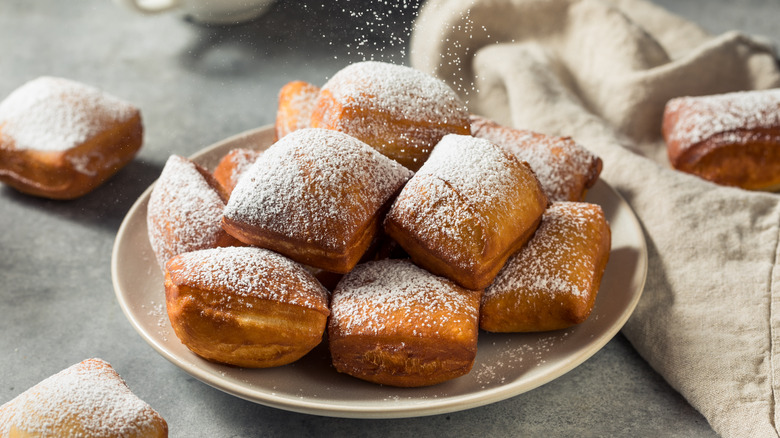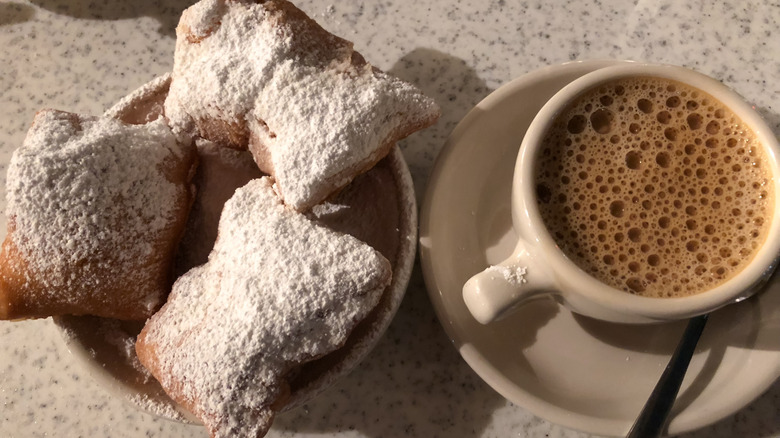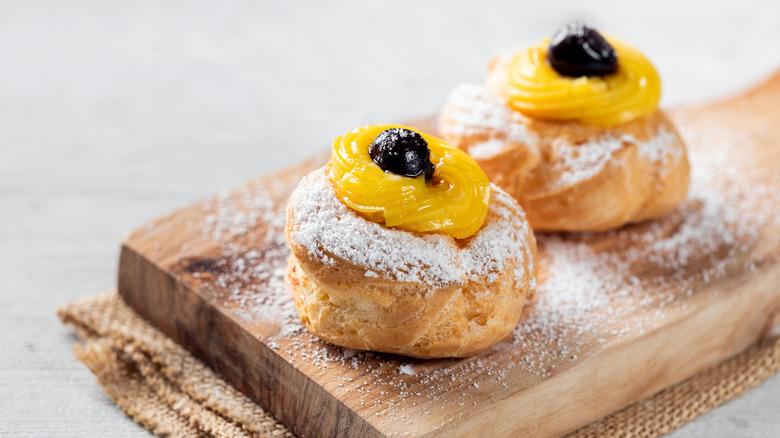The Actual Difference Between Zeppole And Beignets
We've been there: While frequenting your local Italian café and noticing a delectable stack of fluffy beignets in the display window, you may have been left scratching your head and questioning to yourself, "I thought those were French?" You weren't wrong — they are, indeed, French, however, Italy happens to have its own version of the famous fried pastries adored across New Orleans. Known as zeppole, the Italian rendition of a beignet may look similar with its crispy outside buried in a mound of powdered sugar, but in reality, their composition is a bit different.
Understandably, confusing the two is an easy mix-up. Both sweet treats are traditionally made from choux pastry, which is a sweet mixture made to be heated on the stove. It has a consistency somewhere in the middle of a batter and a dough, but when used in zeppole, the mixture tends to be a bit stickier than when it's made for beignets. What's more, the zeppole mixture is spoon-dropped or piped into oil, rather than being shaped by hand into a square or rectangle like beignets usually are. While beignets are almost always exclusively drowned in a shower of powdered sugar, you might also see zeppole topped with cinnamon sugar or granulated sugar instead.
What are beignets?
Beignets are similar to a doughnut in their texture, and the dough has a similar taste, though it's less sweet. Traditional ingredients are rather simple and include lukewarm water, sugar, evaporated milk, bread flour, shortening, oil or lard for frying, and powdered sugar for the topping. When fried, they have a scent that is close to that of a funnel cake.
Interestingly, even though the beignets we all know and love can be traced back to France, the French picked up the concept for the sugary confection from Rome. When French settlers migrated to the United States in the 17th century, it's thought that they introduced beignets to Louisiana, where they eventually became a staple in southern French cuisine. If you aren't local to Louisiana, coming across these culturally iconic confections can be a bit tricky. But if you've visited the state, you know you can find beignets in just about any restaurant, café, or bakery in New Orleans to be enjoyed with café au lait or iced coffee for an everyday breakfast.
What are zeppole?
Much like beignets, zeppole are very close to a doughnut. In Italy, all of the most important holidays have a staple food or dessert, which typically comes with a symbolic history behind its association with that day. While the exact origin of zeppole in Italy is not known, this delicate dessert is commonly associated with St. Joseph's Day — a Catholic feast day — because many believe that St. Joseph himself popularized the confection. Now celebrated by Italians on March 19, St. Joseph's Day also marks Father's Day in many countries, including Italy.
Zeppole comes in numerous different versions. The most common is the traditional variation, which involves piping a sticky dough mixture into hot oil, frying, and completing with powdered sugar. However, some people prefer to add fillings like ricotta mixed with small pieces of chocolate, candied fruits, and honey. Zeppole can also come in savory forms. For instance, in parts of Calabria, fried dough is stuffed with anchovies or sultanas to be consumed on New Year's Eve and New Year's Day. In Malta, anchovy zeppole are traditionally made for Lent during the fasting period.
Beignets can be made with yeast
The biggest difference between a beignet and zeppole is the type of dough used and how it is formed. Depending on whether one is making the French version or the New Orleans version of a beignet, either a more French-style choux pastry can be used, or a yeast pastry, which is frequently seen at the big-name New Orleans bakeries like Café du Monde in the French Quarter. Zeppole, on the other hand, usually sticks to choux pastry instead of yeast pastry.
When crafting beignets, a yeast dough is formed that should then be refrigerated to stiffen it up to cut. Next, the dough is rolled into a thin, oblong shape and cut into two-inch squares or rectangles. After frying in hot oil and reaching that classic "puff" shape, the beignets are finally ready to be liberally topped off with powdered sugar. As far as variety goes, the traditional way to serve is simply with powdered sugar, but many New Orleans bakeries have added their own twists like stuffing them with berries or plantains.
Zeppole tend to be airy from adding ricotta
Zeppole are typically made from the same dough that the traditional French version of a beignet uses, which is choux pastry. Their consistency can vary, depending on the recipe, anywhere from light and puffy to bready or pasta-like. However, it is agreed upon that getting the right consistency — a wet, sticky dough that is ideal for piping — is key when whipping up a batch of this Italian treat.
Many traditional zeppole recipes involve adding ricotta to the batter mixture, which is an ingredient never seen in beignets. This is often what makes the batter sticky, so it can be piped or spoon-dropped directly into hot oil for frying, unlike beignets, which are first rolled out and cut into squares. Moreover, since many zeppole recipes do not use yeast as American beignets do, this is another factor that contributes to their more airy consistency. Again, recipes do vary and some may include yeast, but using choux pastry (which doesn't incorporate yeast) is most common.




